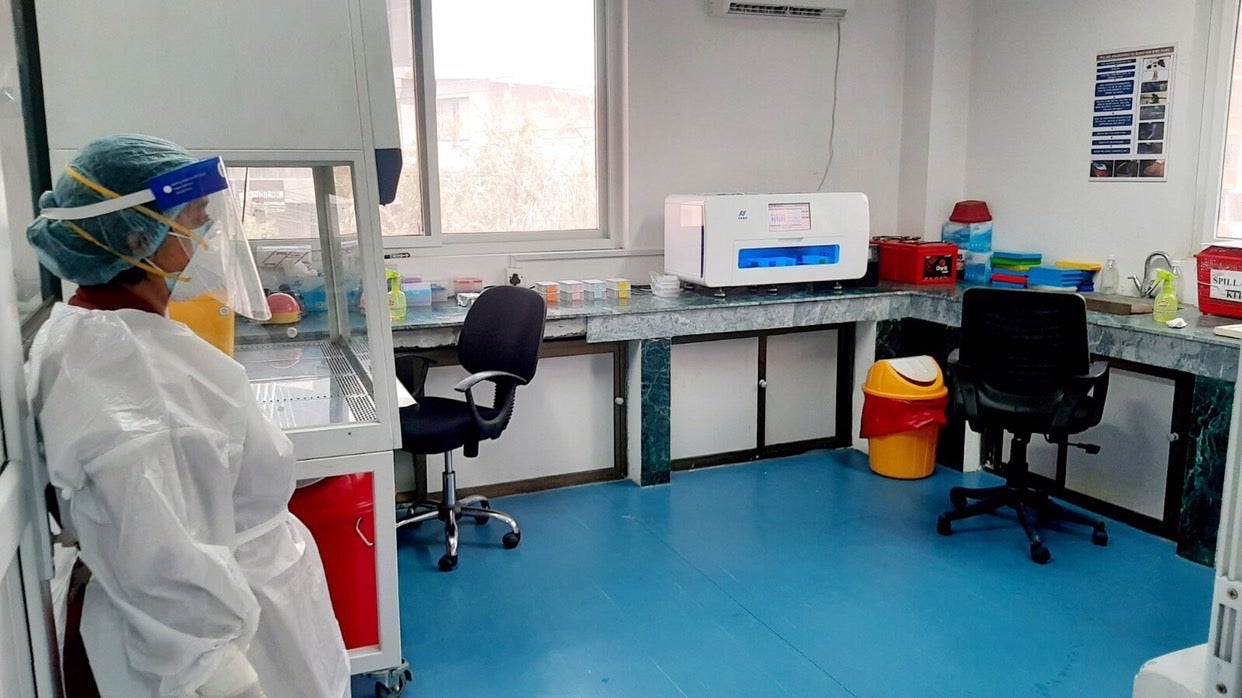 Dr. Runa Jha at the Nepal Public Health Laboratory that performs up to 2,000 tests per day.
Dr. Runa Jha at the Nepal Public Health Laboratory that performs up to 2,000 tests per day.
For Dr. Runa Jha, Director of Nepal Public Health Laboratory, the past nine months have been some of her busiest. "When the first case of COVID-19 was identified in Nepal, ours was the only lab that was able to conduct the necessary molecular testing for diagnosing COVID-19. We had only 6-7 core staff, and our testing capacity was only 40-50 per day," recalls Dr. Jha.
The World Bank-financed Nepal COVID-19 Emergency Response and Health Preparedness Project implemented by the Ministry of Health and Population has helped step up lab capacity and expand testing. The $29 million project has until now financed 565,000 RT-PCR test kits with reagents, seven automated RNA extraction machines, and upgradation of the national laboratory.
With support from the project as well as from other partners and through the government’s own resources, Nepal has increased testing capacity to about 22,000 daily tests.
The test kits and automated RNA extraction machines were distributed to various COVID-designated hospitals and labs in all seven provinces. Nepal also bought an extra 100,000 RT-PCR test kits through UNICEF thanks to a $1.88 million grant from the Pandemic Emergency Financing Facility. With support from the project as well as from other partners and through the government’s own resources, Nepal has increased testing capacity to about 22,000 daily tests.
Today, 43 public, and 27 private labs across the seven provinces of Nepal are actively conducting testing for COVID-19 . "With an added PCR machine, automatic extraction machines, labs, human resources, and shifts, we are now able to perform 2,000 tests per day," says Dr. Jha.
As of November 5, 2020, Nepal has conducted 1,507,190 RT-PCR tests, more than 12.3 percent of which came back positive—a rate much higher than the five percent baseline recommended by the World Health Organization. In the last month, the daily test positivity rate has remained above 15 percent, with a record of 34.8 percent nationally on October 26.
"While it is important to bring new and faster technologies to detect cases, it is equally important to increase the number of health professionals and their support system to strengthen lab and hospital capacity all across the country," advises Dr. Jha in light of the current state of the pandemic in Nepal.
The current festival season and winter arrival will likely increase transmission rates, putting health systems to a crucial test.
With only 50 cumulative tests per 1,000 people, Nepal needs to continue expanding testing. Contact tracing also remains a challenge due in part to human resource constraints in the public health system and the social stigma associated with the virus.
When the lockdown was partly lifted in Mid-July, new cases surged. For the last three months, there has been an upward trend in the number of new cases and a shift of profile from younger male migrants to elderly and female population, evident of virus spreading into the community . The current festival season and winter arrival will likely increase transmission rates, putting health systems to a crucial test.
Addressing this looming crisis will require:
- Expanding case investigation and contact tracing by mobilizing and organizing community volunteers besides health workers;
- Increasing testing of non-symptomatic population in communities of emerging outbreaks;
- Increasing community communication and participation to reduce stigma.
At the same time, the country should simultaneously work to expand isolation and treatment for those who require hospital care. The onus is also on all Nepalis to adhere to standard safety and precautionary measures, including masks, regular handwashing, and practicing social distancing, quarantine, and isolation to protect oneself and others from the pandemic.





Join the Conversation